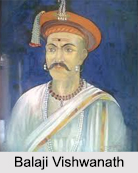 In the 18th century, the Peshwas became the holders of the Maratha Power; Balaji Vishwanath assisted a young Maratha Emperor Shahu to consolidate his grip on a kingdom that had been racked by civil war and persistent attack by the Mughals under Emperor Aurangzeb. Balaji Vishwanath was known as the second founder of the Maratha State.
In the 18th century, the Peshwas became the holders of the Maratha Power; Balaji Vishwanath assisted a young Maratha Emperor Shahu to consolidate his grip on a kingdom that had been racked by civil war and persistent attack by the Mughals under Emperor Aurangzeb. Balaji Vishwanath was known as the second founder of the Maratha State.
Early Life of Balaji Vishwanath
Born into a Chitpavan Brahmin family, Balaji Vishwanath was born on 1st January, 1662 and hailed from the coastal Konkan region of present day Maharashtra and were the hereditary Deshmukh for Shrivardhan under the Siddi of Janjira. Balaji began his career as an accountant for the Maratha general, Dhanaji Jadhav, at Chiplun. As far as the personal life of Balaji is concerned, he was married to Radhabai and was the father of two sons Baji Rao and Chimnaji Appa.
Appointment of Balaji Vishwanath as Peshwa
Balaji Vishwanath was appointed as Peshwa on 16th November, 1713 by Shahu since he was delighted with Balaji"s success in capturing most of the Konkan coast. Earlier, Shahu had sent a large force under his former Peshwa Bahiroji Pingale but Tukuji Angre defeated Pingle and imprisoned him at Lohagad, and started to advance towards Shahu`s capital Satara. Shahu commanded Balaji again to raise another army to subdue Tukuji Angre. But Balaji Vishwanath preferred the path of negotiation and was appointed as Shahu`s diplomatic advisory to negotiate with the admiral. Balaji and Tukuji Angre met at Lonavala and the newly appointed Peshwa appealed to Tukuji"s patriotism for the Maratha cause. Angre agreed to become the Sarkhel or admiral of Shahu`s navy with control of the Konkan. Balaji and Angre then jointly attacked the Muslim Siddis of Janjira and with their combined forces captured most of the Konkan coast, including Balaji`s birthplace of Shrivardhan, which became part of the Angre fiefdom.
Expansion of Maratha Empire under Balaji Vishwanath
With the demise of Aurangzeb, the Mughal Empire started weakening and an internal conflict started within the imperial family and civil war was rolling up. In 1713, Farrukhsiyar came to the throne with the help of the Sayyid brothers. Differences soon arose between them and the Emperor. In 1716, Balaji was arrested by Shahuji`s army chief Dabhaji Thorat and was released in 1718. After his release, Balaji negotiated a treaty with the Sayyid brothers but the Mughal emperor later refused to sanction. Later one of the Sayyid brothers, Husain Ali marched to Delhi and dethroned Farrukhsiyar with the help of Maratha troops commanded by the gallant Parsoji Bhonsale. Rafi-ul-darjat was substituted on the place of Farrukhsiyar in February 1719. A strong troop of 15,000 armies was supplied by the Marathas to enforce the Mughal Empire`s authority in the Deccan. In lieu of Balaji`s help, he received a formal autonomy of the Maratha states ruled by the Peshwas. He was also granted the right to collect the Chauth tax in six Deccan territories. However, as a result of the campaign against the Mughals, Balaji`s health suffered considerably and he died on April 2, 1719. After the demise of Balaji, his elder son, Balaji Baji Rao I, succeeded him and was appointed as Peshwa by Chattrapati Shahu.
It was Balaji Vishwanath who had laid the foundation for the complex administrative system of the Marathas that held sway for a century after his death. The Maratha tax collection system from a wide swath of nominally Mughal provinces was based on a widespread network of agents and collectors. The mechanism of revenue collected was supported by credit facilities from established banking families.






































